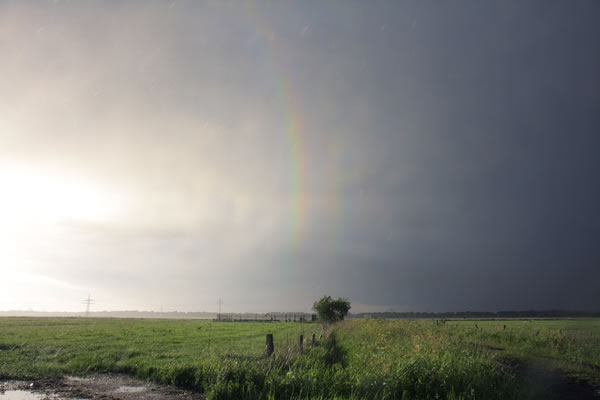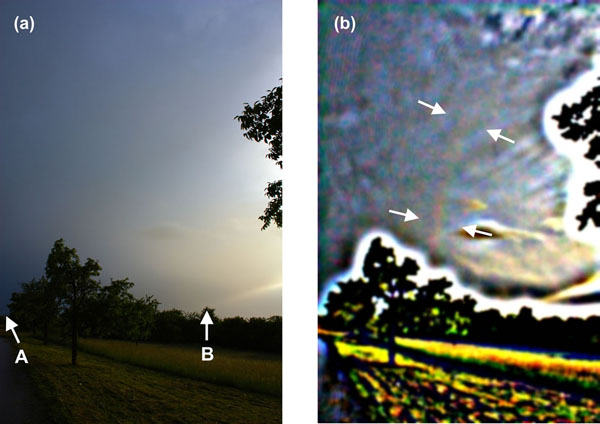Scientific reports of tertiary rainbows are rare - only five in 250 years - putting them firmly in the category of myth. Such an optical rarity, caused by three reflections of each light ray within a raindrop, have finally been confirmed, thanks to photographic perseverance and a new meteorological model that provides the scientific underpinnings to find them.
In addition to the confirmed photo of a tertiary rainbow, the optical treasure hunt went one step further, as revealed in another photo that shows the shimmering trace of a fourth (quaternary) rainbow.
Raymond Lee, a professor of meteorology at the U.S. Naval Academy, did not snap the picture below, but he predicted how tertiary rainbows might appear and challenged rainbow chasers to find them.

The third-order (tertiary) rainbow (left), accompanied by the fourth-order (quaternary) rainbow (right). They appear on the sunward side of the sky, at approximately 40° and 45°, respectively, from the Sun. This is the first picture ever of a quaternary rainbow in nature and the second picture ever of a tertiary rainbow. Credit: Michael Theusner/Applied Optics
Tertiary and quaternary rainbows are natural products of the combination of refraction, dispersion, and reflection inside raindrops - the same processes that create all rainbows, yet they are taken to their most extreme to produce these higher order variants. Refraction is when sunlight bends as it moves from air into water and vice versa. (Such bending makes oars look bent when partially submerged.) Water droplets bend each of the colors in sunlight by a slightly different angle. This is called dispersion, and it separates the colors to create a rainbow.
Most of that multicolored light passes through the other side of the raindrop, but some is reflected. The raindrop's spherical curves concentrate those reflections at 138 degrees from the Sun. This concentrated light is bright enough to create a visible primary rainbow.
A double rainbow occurs because not all that light exits the raindrop. Some is reflected back into the raindrop and goes through the whole process again. Although this light is dimmer, sometimes it is bright enough to produce a secondary rainbow just outside the first.
A third series of reflections creates a tertiary rainbow. It is even dimmer than the secondary rainbow, and much harder to find because instead of forming away from the Sun, a tertiary rainbow forms around the Sun. To see it, observers have to look into the Sun's glare.
This may be why only five scientifically knowledgeable observers had described tertiary rainbows during the past 250 years.
Lee reviewed each description. He eliminated one questionable account and found common elements in the others. All described tertiary rainbows that appeared for a few seconds against a dark background of clouds about 40 degrees from a brightly shining sun.
Along with colleague Philip Laven, Lee used a mathematical model to predict what conditions might produce visible tertiaries. First, they needed dark thunderclouds and either a heavy downpour or a rainstorm with nearly uniformly sized droplets. Under these conditions, if the Sun broke through the clouds, it could project a tertiary rainbow against the dark clouds nearby. The contrasting colors would make the dim tertiary visible.
(a) Original image of a third-order (tertiary) rainbow. The image was taken May 15, 2011, in Kampfelbach, Germany and is the first-ever picture of a tertiary rainbow. Two reference positions (A and B) for image orientation are indicated. (b) Processed version of image (a) after contrast expansion and unsharp masking, showing a rainbow-like pattern next to the image center, marked by the arrows. Credit: Michael Grossman/Applied Optics.
When Lee presented his findings at last year's International Conference on Atmospheric Optics, it sparked heated discussion. Some scientists insisted that past descriptions were wrong and that tertiaries were too dim to see in the Sun's glare.
One attendee, Elmar Schmidt, an astronomer at Germany's SRH University of Applied Sciences in Heidelberg and a rainbow chaser, took the guidelines as a challenge and alerted like-minded amateurs. Since then, Michael Grossman and Michael Theusner have snapped photos of tertiary rainbows. One photo even shows a quaternary rainbow, and both images, which underwent only minimal image processing to improve the contrast under these challenging photographic conditions, appear in the same Applied Optics special issue as Lee and Laven's paper.
The day Grossman photographed the tertiary rainbow, he first recalled seeing a double rainbow. When the rain intensified, he knew he had to turn toward the Sun. "It is really exaggerated to say that I saw it, but there seemed to be something," he says. The pictures he snapped in the rain were the first to show a tertiary rainbow.
Of the noteworthy discovery, "it was as exciting as finding a new species," Lee says.




Comments